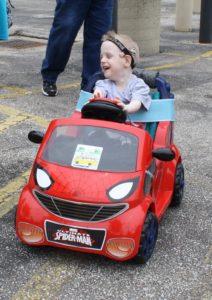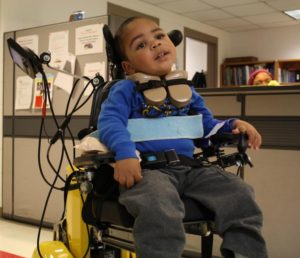July 15, 2016
by: LeafBridge Services Contributor
The Importance of Early Mobility
 This week’s blog was written by Katie McGregor MOT, OTR/L, an occupational therapist at LeafBridge with 16 years of pediatric experience in classrooms, private centers, and outpatient clinics. Katie developed a passion for assistive technology through many years of early intervention work at the Aaron W. Perlman Center in Cincinnati. Areas of interest include early power mobility, computer access, speech generating device access and transdisciplinary assistive technology evaluations and fittings. Katie is a leader in promoting assistive technology through family education and professional development presentations about assistive technology, emphasizing the importance of early integration, specifically with the complex child.
This week’s blog was written by Katie McGregor MOT, OTR/L, an occupational therapist at LeafBridge with 16 years of pediatric experience in classrooms, private centers, and outpatient clinics. Katie developed a passion for assistive technology through many years of early intervention work at the Aaron W. Perlman Center in Cincinnati. Areas of interest include early power mobility, computer access, speech generating device access and transdisciplinary assistive technology evaluations and fittings. Katie is a leader in promoting assistive technology through family education and professional development presentations about assistive technology, emphasizing the importance of early integration, specifically with the complex child.
It is believed by many, particularly parents and even some medical professionals, that providing power mobility will hinder a child’s motivation to walk or even the developmental skills to learn to walk. I have heard many things from parents such as; “I want my child to walk”, “I just want a stroller”, “Won’t a power chair make my child lazy?” However, this is further from the truth and research is supporting the importance of early independent mobility, more and more.
Typically developing children start to crawl between 9 and 12 months of age and walk between 12-15 months of age. Crawling, rolling, scooting and walking are essential to develop the sense of exploration, spatial awareness and visual and cognitive skills. Children with physical and vision related limitations may not crawl or walk at the same rate as their typically developing peers. However, having a disability does not mean they should miss out on having the same experiences as their typical peers. Assistive technology (adaptations to equipment to improve accessibility), can level the playing field for children with disabilities to have similar mobility experiences and therefore gains in social, cognitive, visual and spatial awareness, as their peers.
 One way to help facilitate early mobility is by adapting ride-on cars with switches or any means of access. In 2015, UCP of Greater Cleveland, along with Cleveland Clinic Children’s Rehab, participated in one of the largest workshops to adapt these ride on cars, called GoBabyGo. GoBabyGo was developed at the University of Delaware by Dr. Cole Galloway. Dr. Galloway has conducted extensive research regarding the impact of mobility and developmental growth in infants as young as 7 months of age. His research proves that early mobility can provide significant developmental benefits. These devices are used to augment mobility. Therefore, “with supervision of an augmented mobility experience, that child can gain significant developmental benefit from having an opportunity to move themselves through space that they might otherwise not have. An infant who does not have the ability to scoot on the floor, roll, crawl, but can make a mobility device move, can gain important experiences from this.”
One way to help facilitate early mobility is by adapting ride-on cars with switches or any means of access. In 2015, UCP of Greater Cleveland, along with Cleveland Clinic Children’s Rehab, participated in one of the largest workshops to adapt these ride on cars, called GoBabyGo. GoBabyGo was developed at the University of Delaware by Dr. Cole Galloway. Dr. Galloway has conducted extensive research regarding the impact of mobility and developmental growth in infants as young as 7 months of age. His research proves that early mobility can provide significant developmental benefits. These devices are used to augment mobility. Therefore, “with supervision of an augmented mobility experience, that child can gain significant developmental benefit from having an opportunity to move themselves through space that they might otherwise not have. An infant who does not have the ability to scoot on the floor, roll, crawl, but can make a mobility device move, can gain important experiences from this.”
RESNA is the Rehabilitation Engineering & Assistive Technology Society of North America. They have a position on early mobility, specifically as it relates to power mobility, which states it is important for those appropriate in order to “promote psycho-social development, reduce learned helplessness, and to facilitate social and educational integration and independence.” By working with your physical and occupational therapists, an access method and most appropriate mobility device (manual or power wheelchair) can be determined and ordered.
 One thing to consider when providing mobility is that your child may have various mobility devices for different environments. Your child may use a walker in a classroom or within the home, but may need a wheelchair for recess or trips. A manual wheelchair requires a lot of exertion and can be fatiguing over time. Therefore, a power wheelchair should not be ruled out, even if your child is ambulatory.
One thing to consider when providing mobility is that your child may have various mobility devices for different environments. Your child may use a walker in a classroom or within the home, but may need a wheelchair for recess or trips. A manual wheelchair requires a lot of exertion and can be fatiguing over time. Therefore, a power wheelchair should not be ruled out, even if your child is ambulatory.
Additionally, power wheelchairs for children with visual and cognitive delays should not be ruled out. As stated above, power mobility that provides independence can only enhance those developmental areas. The sooner mobility is started, the greater the chance for independence. It is very different to be an active mover vs. a passive mover (being pushed around). The same developmental experiences do not occur, therefore developmental growth in vision, cognition, spatial awareness and social interactions may not occur. Children that do not have active mobility can also develop learned helplessness. The research has found that learned helplessness can occur in children as young as 4 years old. Therefore it is imperative to provide independent mobility in all environments, even if that means having a variety of mobility devices.
The take home: have your child start mobility early to prevent learned helplessness or lack of an internal drive. Early INDEPENDENT mobility (specifically using assistive technology or power mobility) is necessary, and WILL NOT impede other developmental milestones, such as walking, or make your child “lazy.” Independent mobility should be introduced sooner rather than later – even younger than 14 months. It can improve cognitive development, visual skills, social interactions and overall function and should not be looked at as a negative thing or taking steps backward. Some quotes from parents after their children received a power wheelchair were:
- “She got to go where SHE wanted for the first time… and ended up in the toy isle…it was so nice.”
- “My child is so happy, now that they can move on their own.”
- “I am so pleased my child was introduced to power mobility!”

Leave a Reply